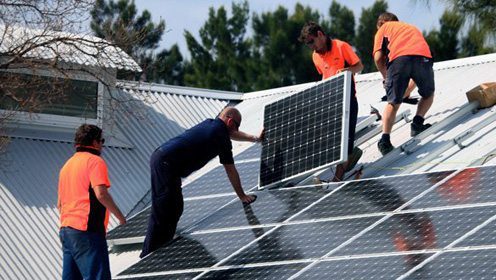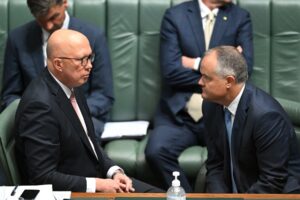The welfare lobby has a stronger case than anyone to rail against the absurd levels of electricity prices in Australia, and the energy stress it is causing for consumers. Low income households are struggling, and some are being disconnected. Small businesses are having to close.
But the decision of the welfare groups to put some of the blame on solar households, and the suggestion that they are freeloading on others, is fraught with risks – not just for electricity prices in general, but because it is likely to worsen the very problem they are looking to solve.

The fossil fuel lobby has long sought to demonise rooftop solar as a “transfer of wealth” from rich households to poor, even though the statistics do not support this. This tactic has now been adopted to attack battery storage, and even electric vehicles, as we note in this story we publish today.
The argument is that solar, battery storage and EVs are a “transfer of wealth from the industry to consumers,” which is so laughable in the context of the record profits and ridiculous prices charged to electricity consumers that it beggars belief.
But the fact that many in the welfare lobby echo these talking points, even to the point of supporting higher fixed charges and solar taxes, is causing great frustration to solar advocates who argue there are much smarter ways to address what is a very important issue – access to clean technology for low-income households, renters and apartment dwellers.
Welfare groups led by ACOSS on Monday released a report looking at the soaring cost of electricity and the “energy stress” on consumers, correctly blaming a decade with no policy certainty, mismanagement, high network costs and a lack of competition in the wholesale markets.
But some aspects of the report alarmed solar advocates, and this was confirmed by news reports quoting spokespeople for the welfare lobby putting much of the blame of high bills on solar, when costs associated with renewable energy schemes reflect just a tiny portion of bills – even on the welfare group’s own figures.
One of the report’s major recommendations was to call on COAG Energy Ministers “to investigate further how to address inequitable allocation of the costs associated with the transition and growth of distributed energy resources, to ensure the transition to clean energy is more equitable and inclusive.”
That recommendation referred to this clause in the report, on page 28.
“The costs of network expenditure and renewable energy policies (the RET, the Small-scale Renewable Energy Scheme (SRES), state feed-in tariffs and energy saving schemes) are currently recovered on electricity bills through charges applied to each unit of energy consumed.“If a household has distributed energy resources, their energy bills are small or zero and in some cases can be in credit. These households are paying little if anything towards network expenditure and renewable energy policies, whereas households without distributed energy – including low-income and disadvantaged households – pay the full amount.”
And it underlines this important point: It is not the actions of solar households that should be under scrutiny, but the total pool of revenue that the networks seek to recoup from their customers. Gold plating on the poles and wires was rampant, as any number of reports in the last week have confirmed.
And, at a time when networks and generators are making more money than they ever before, the very idea (propagated by the fossil fuel lobby) that they should complain about a transfer of wealth from generators to consumers is laughable.
What should be proposed is a write down of their assets, not a write-down of the benefits that solar households can obtain.
Secondly, households in Australia are already paying significant fixed prices. In the region controlled by Essential Energy in NSW, for instance, customers are paying $1.57 a day just for the network connection – that’s $573 a year.
It is an outrageous fee that applies to solar and non solar households alike, and hits low usage households hardest because it means that low usage households – those using around 1MWh a year – are paying around 80c/kWh for their electricity. Households using 2MWh a year (or 6kWh a day) are effectively paying 60c/kWh.
Those rates are usurious, a scandal and cannot be justified.
Just how these charges are allowed to stand in Australia, let alone the standard rate of 40c/kWh (volume tariffs plus the fixed charges), shows just how the regulatory and supervisory bodies in Australia have either been asleep or completely lost the plot, and/or become beholden to the slick lobbying and pseudo-economics of the industry.
The other half of the bill comes from wholesale and retail markets, which while not owned by a monopoly is still run by an oligopoly who in the last year have demonstrated their ability to control and manipulate pricing to their advantage.
It is obvious that the best way to address this is through more competition. Even the ACCC recognises this. One way is to have more players at the big end of town, building wind and solar farms and pumped hydro and grid scale battery storage.
Another obvious option is to encourage consumers, households and businesses, to invest in their own resources – solar and storage. Given that solar costs less than 10c/kWh, everything should be done to make this available to low income households.
To encourage that, however, requires policies that reward such investment, not penalise them with talk of solar taxes, higher fixed fees and penalties for leaving the grid.
It is all too easy to add up the supposed costs of all the different schemes that encourage renewables, but too rarely are the benefits considered.
Recent criticisms of the renewable energy target have talked of costs of $3 billion a year – which is a falsehood in any case, because it completely misrepresents the number of renewable energy certificates sold at the market price, and it does not consider the benefits of reduced wholesale prices.
The same criticisms have been laid out against rooftop solar. But again, the benefits are rarely considered. One recent report, from Energy Synapse, pointed to the huge benefits that solar played in the summer months, saying rooftop solar saved nearly $1 billion in wholesale electricity costs during the NSW February heatwave.
https://reneweconomy.wpengine.com/rooftop-solar-saved-nsw-consumers-nearly-1-billion-heatwave-45093/
Network after network have spoken of the ability of rooftop solar to narrow, and delay peak demand periods. This saves money, although it does require incumbents to think differently about their business models. Rooftop solar should not be the scapegoat.
Some state governments are now seeking to identify more of these benefits and have them reflected in feed-in tariffs. Victoria’s regulatory body ascribed a value for the avoided cost of carbon to its feed-in tariff. It put environmental and network benefits into the too-hard basket.
The problem of lower revenue from solar owners could be largely overcome by moving to tariffs which are based more on usage during evening peaks, which is what has been driving the need for new network investment.
Solar owners would pay the same as everyone else for their usage during peaks. But ironically, more cost reflective network tariffs have been opposed by some of the same welfare groups.
The position of the welfare lobby has frustrated many in the solar sector. But such are their delicate relationships that most chose to go off the record.
One chose to go on the record:










